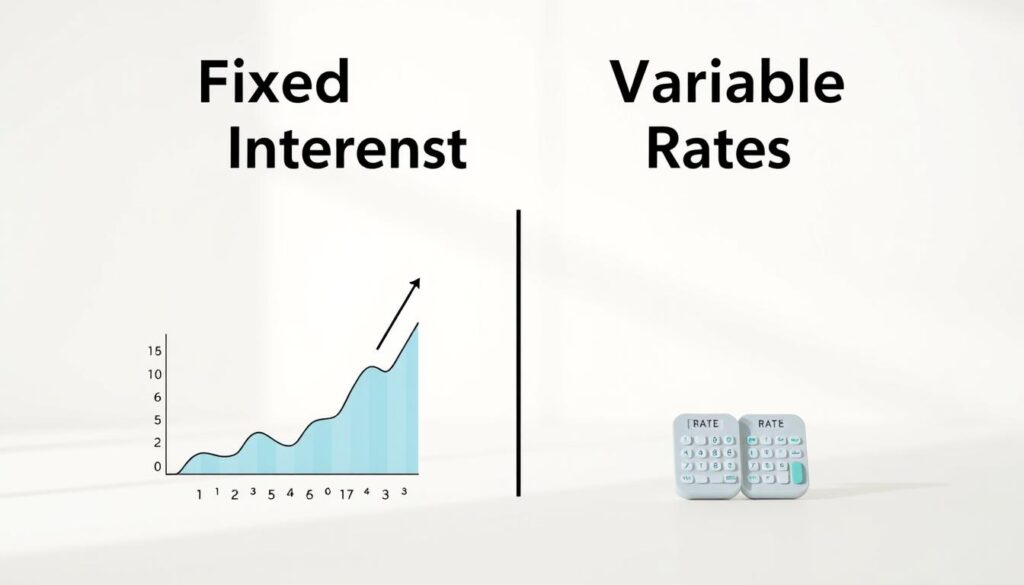Unlock Affordable College Loans: Find the Right Fit
Finding financial aid for college can be tough. But knowing your options is key. Nearly 70% of students graduate with significant debt. So, it’s important to look for affordable student loan options.
We’ll help you find the right loan for your budget. There are many loans out there. It’s important to know the differences and how they affect your future.
Learning about the best student loan rates and terms can save you money. Making smart choices now can help you in the long run.
Key Takeaways
- Understanding your student loan options is crucial for making informed decisions.
- Various loan types are available, each with its own terms and conditions.
- Comparing rates and terms can help you save money.
- It’s essential to consider the long-term impact of your loan choices.
- Exploring affordable options can significantly reduce your debt burden.
Understanding College Loans: An Overview
The cost of going to college keeps going up. It’s more important than ever to know about college loans. These loans help many students pay for tuition, living costs, and more.
What Are College Loans?
College loans are money given to students for their education. They can come from the government or private lenders. Federal student loans are from the government. Private student loans are from banks and other lenders.
Types of College Loans Available
There are many types of college loans. Federal student loans include Direct Subsidized and Unsubsidized Loans, PLUS Loans, and Perkins Loans. Private student loans vary but often have different rates and terms.
Importance of College Loans in Education
College loans are key to making college affordable. They help students who can’t pay for college right away. It’s important to understand the different loans and their effects.
| Loan Type | Interest Rate | Repayment Terms |
|---|---|---|
| Federal Student Loans | Fixed | Various income-driven plans |
| Private Student Loans | Variable or Fixed | Varies by lender |
It’s crucial to understand college loans to navigate higher education financing. Knowing what college loans are, the types, and their importance helps students make better financial decisions.
Federal vs. Private College Loans: What’s the Difference?
Choosing between federal and private loans is a big decision for college. It’s important to know the differences between these loans.
Federal College Loans: An Introduction
Federal college loans are backed by the government. They have lower interest rates and flexible repayment plans. They also offer protections like deferment and forbearance during tough times.
Private College Loans: Key Features
Private loans come from banks and credit unions. They might not have the same protections as federal loans. But, they can be a good choice if you’ve used up all your federal loans.
Choosing Between Federal and Private Loans
Choosing between federal student loans and private student loans needs careful thought. Federal loans often have better terms, like lower fixed rates and income-driven plans. But, private loans can give you more money if you need it.
Knowing the differences helps you choose the right loan for your college costs. Think about interest rates, repayment options, and benefits. This way, you can pick the loan that fits your financial situation and goals.
Steps to Apply for College Loans
Understanding the steps to apply for college loans is key. The process can seem complex, but breaking it down helps. This way, you can handle it more easily.
Preparing Necessary Documentation
The first step is to prepare your documents. You’ll need personal ID, financial statements, and academic records. Make sure you have everything ready to avoid delays.
Completing the FAFSA Form
The Free Application for Federal Student Aid (FAFSA) is a big part of the process. It’s important to fill out the FAFSA form correctly and on time. This form asks for your financial details, so have your tax returns and other documents ready.
Researching Lenders and Loan Options
After filling out the FAFSA, research different lenders and loans. Look at interest rates, repayment terms, and fees. Choose a loan that fits your financial situation and goals.
Interest Rates Explained: Fixed vs. Variable
When it comes to college loans, knowing the difference between fixed and variable interest rates is crucial. The interest rate you choose can greatly affect your financial obligations over the loan’s life.
What Are Fixed Interest Rates?
Fixed interest rates stay the same for the loan’s entire term. This means your monthly payments will always be the same, making budgeting easier. Fixed interest rates offer stability and predictability, which is great when interest rates are rising.
Understanding Variable Interest Rates
Variable interest rates, by contrast, can change with market conditions. They might start lower than fixed rates but can go up, leading to higher payments. It’s vital to grasp the risks of variable interest rates and think about your financial situation and market forecasts.
How to Choose the Right Rate for You
Deciding between fixed and variable interest rates depends on your financial situation, risk tolerance, and market expectations. To make a wise choice, consider these factors:
- Your financial stability and ability to handle rate increases
- The current interest rate environment and market trends
- The loan term and how rate changes might affect you
To better understand the differences, here’s a comparison table:
| Feature | Fixed Interest Rates | Variable Interest Rates |
|---|---|---|
| Rate Stability | Remains the same | Changes with market conditions |
| Monthly Payments | Consistent | May increase or decrease |
| Risk Level | Low | Moderate to High |

By understanding fixed and variable interest rates, you can make a choice that fits your financial goals and risk tolerance.
Repayment Plans for College Loans
Understanding college loan repayment can seem tough. But knowing your options is key to financial freedom. Repayment plans help manage debt, offering flexibility and relief.
Standard Repayment Plan
The Standard Repayment Plan is the default for most federal student loans. It has fixed monthly payments over 10 years. It’s good for those who can afford the payments, paying off the loan faster and less interest.
Key Features: Fixed monthly payments, up to 10 years to repay, less interest paid overall.
Income-Driven Repayment Plans
Income-Driven Repayment (IDR) plans adjust payments based on income and family size. They’re great for those facing financial struggles or high debt. There are several IDR plans, like Income-Based Repayment (IBR) and Pay As You Earn (PAYE).
Benefits: Lower monthly payments, chance for loan forgiveness after a period.
| IDR Plan | Monthly Payment | Forgiveness Period |
|---|---|---|
| Income-Based Repayment (IBR) | 15% or 10% of discretionary income | 20 or 25 years |
| Pay As You Earn (PAYE) | 10% of discretionary income | 20 years |
Loan Forgiveness Options
Loan forgiveness programs can wipe out part or all of your debt. Public Service Loan Forgiveness (PSLF) is for those in public service. Other options depend on your job or employer.
Eligibility: Usually needs a job in a qualifying field or employer, and making qualifying payments.
Building Your Budget: College Costs and Loans
To handle college expenses and loan repayments, we must create a detailed budget. We need to understand college costs, plan our payments, and budget for living expenses. This way, we can manage our finances during and after college.
Estimating Your Total College Expenses
First, we must estimate our total college expenses. This includes tuition, room and board, textbooks, and other costs. Tuition fees are the biggest expense, but other costs can add up fast.
To estimate your total college expenses, consider the following table:
| Expense Category | Estimated Cost |
|---|---|
| Tuition Fees | $10,000 |
| Room and Board | $8,000 |
| Textbooks and Supplies | $1,000 |
| Miscellaneous Expenses | $2,000 |
| Total Estimated Expenses | $21,000 |
Creating a Monthly Payment Plan
After estimating our total college expenses, we need to plan our monthly payments. We must figure out how much to pay each month for expenses and loans.
To plan our monthly payments, we should look at our income, expenses, and loan terms. A loan repayment calculator can help us find out our monthly payments.

Budgeting for Living Expenses
Budgeting for living expenses is key while in college. This includes rent, utilities, food, and transportation. We should budget carefully to avoid unnecessary debt.
To manage living expenses well, consider these tips:
- Create a budget for all living expenses.
- Prioritize needs over wants.
- Use budgeting apps to track expenses.
Tips for Managing Your College Loans
It’s key to know how to handle your college loans to stay financially stable. Good loan management can save you money and cut down on stress.
Keeping Track of Your Loans
To manage your college loans well, you need to keep an eye on them. This means knowing the loan balance, interest rate, and repayment terms. Use a loan tracker or a spreadsheet to stay on top of your loans.
A report shows that students who track their loans manage their debt better. Investopedia offers great tips on handling student loan debt.
Having a clear record helps you stay organized. It lets you make smart choices about your college loan repayment plans.
Setting Up Automatic Payments
Automatic payments are a smart way to manage your college loans. They ensure you never miss a payment, avoiding late fees and bad credit. Automatic payments also show you’re serious about repaying your loans.
By setting up automatic payments, you can reduce the stress of managing student loan debt. This lets you focus on other financial goals.
Additional Payments: Are They Worth It?
Extra payments on your college loans can be good, but think it through. They can help you pay off your loans quicker and save on interest. But, check if your loan has any prepayment penalties.
Experts say extra payments can save you thousands in interest. So, if you can, making extra payments is a smart move for managing your student loan debt.
Common Mistakes to Avoid When Taking Out Loans
When we take out college loans, it’s key to know the pitfalls that can cause financial trouble. Understanding common mistakes helps us make better choices. This knowledge is crucial when we’re looking for ways to fund our education.
Overspending on Student Loans
One big mistake is spending too much on student loans. It’s tempting to think more is better, but it can be a heavy burden after graduation. To avoid this, we should create a budget for all education costs and stick to it.
As Mark Kantrowitz, a financial aid expert, said, “Borrow only what you need, not what you’re eligible for.”
“Don’t let the availability of loan money dictate your spending habits. Borrow smart, not hard.”
Ignoring Loan Terms and Conditions
Ignoring loan terms and conditions is another big mistake. It’s important to know the interest rates, repayment terms, and any fees to manage our debt well. We should read the loan terms carefully before signing and ask questions if we’re not sure.
For example, some loans have variable interest rates that can go up, making payments higher. Knowing this helps us plan our finances better.
Not Seeking Financial Advice
Not getting financial advice is a mistake with big consequences. Many students go through the loan process alone, missing out on advice that could help them make smarter choices.
Getting financial advice from a professional can be very helpful. They can give advice tailored to our financial situation and goals. Remember, “A penny saved is a penny earned.” Getting advice can save us money and prevent costly errors later on.
Resources for Finding Affordable College Loans
Starting college can be exciting, but finding affordable loans is key. There are many tools and organizations to help you find the right loan. This can make your college journey smoother.
Government Resources and Websites
The government has many resources for affordable college loans. The U.S. Department of Education website is a great place to start. It has lots of info on federal student loans, like who can get them and how to apply.
The College Navigator tool is also useful. It lets you compare colleges by financial aid and loan options. Using these resources can help you make smart choices about your college money.
Nonprofit Organizations to Consider
Nonprofit groups can also help with college loans. Sallie Mae and Nelnet offer advice on student loans. But remember, they mainly deal with private loans.
National Foundation for Credit Counseling (NFCC) member agencies can help too. They offer tips on managing debt and understanding loan choices. These groups can give you valuable advice as you look for college loans.
Loan Comparison Tools
For comparing private student loans, loan comparison tools are super helpful. Sites like NerdWallet and Bankrate let you compare loans. You can see things like interest rates and repayment terms.
Using these loan comparison tools makes finding the best loan easier. It’s important to look at several options to find the best deal for you.
The Role of Credit Scores in College Loans
Credit scores are key in figuring out if you can get a college loan and what interest rate you’ll pay. It’s important to know how they affect you.
Understanding Credit Scores
A credit score is a three-digit number that shows how good you are with money. It looks at your past payments, debts, and how long you’ve had credit.
Credit scores range from 300 to 850. A higher score means you’re doing well financially. For students, a good score can help when applying for loans.
How to Improve Your Credit Score
To boost your credit score, you need a plan. Paying bills on time is a big deal, as it’s a big part of your score.
Other ways to improve include reducing debt and checking your credit reports for mistakes. These steps can help raise your score over time.
Impact of Credit Scores on Loan Options
Credit scores really matter when it comes to college loans. A better score can mean lower interest rates and more flexible payment plans.
As
“A good credit score is like having a financial superpower; it can open doors to better loan options and save you money in the long run.”
But, a lower score might mean worse loan terms or even no loan at all. So, keeping a good credit score is crucial for getting affordable college loans.
Conclusion: Making Informed Decisions About College Loans
Understanding college loans is key in today’s world. We’ve looked at different student loan options and how to manage them. This includes knowing the types of loans and how to pay them back.
Getting the right college loan is all about planning. By looking into various loans, we can choose the best one for us. It’s also important to think about interest rates, repayment terms, and our credit scores.
Key Takeaways for Informed Decision-Making
To manage college loans well, we need to do our homework. Getting advice from financial experts can help a lot. This way, we can confidently pick the best loan for our needs.









